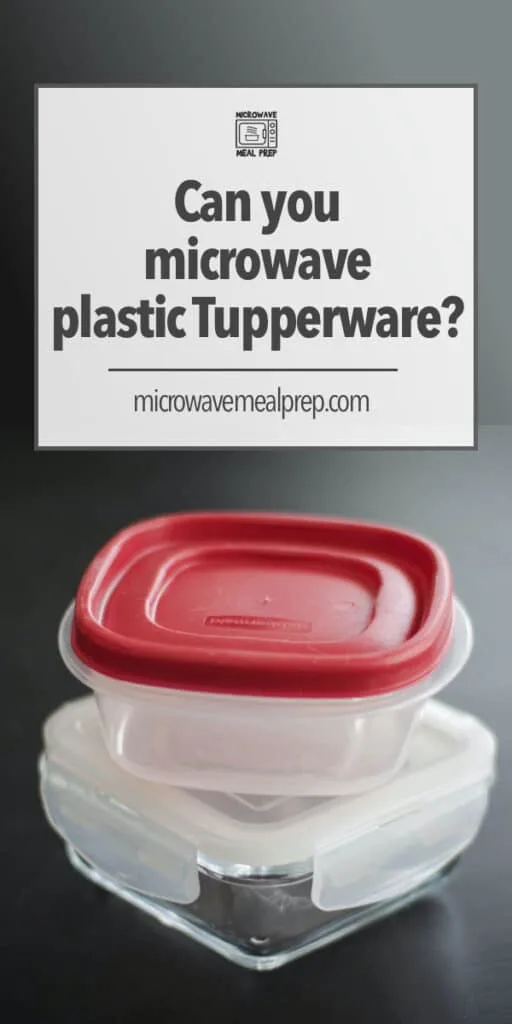Do you microwave plastic Tupperware containers to cook and reheat food? Warming up leftovers or lunchtime meal prep in the microwave is a common practice. Is it bad to use Tupperware in the microwave?
Some friends of mine continuously heat up food in their plastic Tupperware containers in the microwave. Microwaves have been improving cooking speed and kitchen efficiency since the 1946, ironically the same year that Tupperware was invented.
There has been much debate about the overall safety of plastics. Brands like Rubbermaid, Ziploc and GladWare use marketing strategies to sidestep any concerns over the safety of their containers, however I remain skeptical of the functionality of plastic when placed under conditions of extreme heating.
Is microwaving Tupperware safe?
My general concern about using plastic in the microwave has led me down a rabbit hole of research. The general consensus seems to be that all Tupperware containers are microwave safe and can be used without any worry.
Tupperware products are made with plastics, however all Tupperware products are not microwave safe.
Tupperware has thoroughly tested their products to determine which ones are microwave safe. In fact, they state that it is safe to microwave food in Tupperware products that are intended for use in the microwave.
Tupperware Microwave Safe Symbol
There are many plastic compounds available to industrial manufacturers. So which plastics are used in the Tupperware line of products?
My concerns in regards to microwaving Tupperware containers are two fold:
- Plastic melting in the microwave
- Plastic leaching chemicals into food
To reduce the concern of microwaving, Tupperware has shared a comprehensive chart of plastics to help further understand the “Resin ID Codes” found in their extensive line of products.
There is only one way to verify if the Tupperware receptacle is certified safe for microwave use. Check the bottom of the container and look for the microwave safe symbol comprised of 3 wavy lines.

If the Tupperware or plastic container does not have any labels or symbols on the bottom, then don’t use it in the microwave. Don’t even use it to store food!
Although there are many products in the Tupperware line that are not designed for cooking, Tupperware has furthered their research and developed an extensive line that is considered microwave safe and BPA-free. In fact, all items sold by Tupperware in the United States and Canada since March 2010 are BPA free.
Can you microwave Tupperware with lid on?
Microwaving food with a lid helps to prevent unnecessary food splatter.Reheating food with a cover also traps in steam and allows food to heat up much faster, more evenly and also without the concern of drying out.
Microwave safe Tupperware brands have custom designed lids and seals with a steam-vent feature. The vent must be opened when placing sealed containers in the microwave.
Food should be covered, however the lid should not be sealed airtight. If the lid is sealed on tightly, then you risk a catastrophic exploded food mess and possible dangerously intense steam when you reopen the container.
Things to know before microwaving Tupperware containers
Tupperware has a specialized line of products that are classified as microwave safe. However, there are a few important realizations that should be understood about microwaving Tupperware containers.
“Microwave Tupperware products are not designed for cooking and therefore are not recommended for use in a microwave oven except for TupperWave Stack Cooker, Rock ‘N Serve and CrystalWave reheatable products.”
Tupperware
The company recommends that you avoid reheating certain foods that are high fat or sugar content. The risk is that those specific foods can become very hot and cause damage to the containers.
In addition, manufacturer instructions clearly state that foods should be reheated in the microwave on medium heat for no longer than 3 minutes.
If longer than 3 minutes is required to heat the food, then stop the microwave at 3 minutes, remove the lid and stir the food. Then, resume reheating for less than 3 minutes.
Conclusion
If you have had success using Tupperware in the microwave, then it’s easy to continue along the same path. However, even though the products may be labeled “safe for microwave use,” can you really trust the descriptions?
After diving into the subject a little further, I believe that glass and ceramic microwave safe containers are better alternatives to use rather than microwaving plastic Tupperware.
Covered food heats up quicker and more consistently. Consider using a microwave food cover to expedite the reheating process and evenly distribute the heat.
Although Tupperware has developed new products over the past few years, they have provided very strict instructions that must be accurately followed when using microwavable Tupperware:
- Do not cut or scratch the plastic
- Pop the vent
- Reheat food only
- Use medium heat
- 3 minutes or less
- Do not exceed fill-line
Don’t use old or damaged plastic containers in the microwave because they may have exceeded the microwave ability. Doing so also puts the food at risk for encountering toxic release, so throw away old Tupperware or use them for purposes other that food storage.
In addition, Tupperware made before 2010 most likely contains BPA in the plastic compound.
When it comes to the cooking and food storage products that you have, it’s important to understand the uses and misuses.
If you understand the symbols and are confident using microwave safe Tupperware, then I don’t think you should have anything to worry about. However, if you find yourself at all uncertain, then stick with glass or ceramic and simply avoid using all plastics in the microwave.

